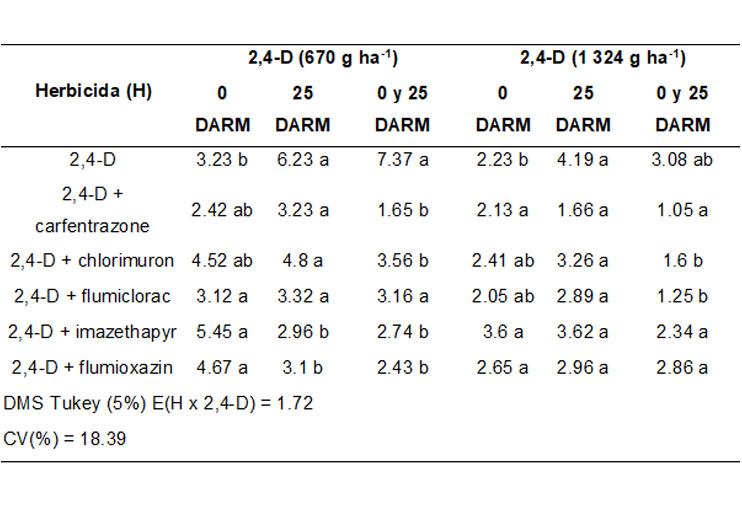Assessment of tolerance to glyphosate and glufosinate in genetically modified cotton shoots
DOI:
https://doi.org/10.29312/remexca.v15i2.3423Keywords:
Gossypium hirsutum, chemical destruction, glytol, regrowthAbstract
Destruction of the harvest of cotton stalks should be done after it. However, destruction by ploughing prevents continuing with direct sowing, which makes chemical management an ally in soil conservation. The objective was to identify the most effective dose of 2,4-D, associated with different herbicides and the timing of administration for the control of transgenic cotton shoots for tolerance to glyphosate and glufosinate. The treatments consisted of the use of the herbicide 2,4-D, alone at doses of 670 and 1 340 g ha-1, and associated with the herbicides carfentrazone, flumiclorac, chlorimuron, flumioxazin and imazethapyr at three application times: 0 days after mechanical mowing (0 DAMM), 25 DAMM, and 0 DAMM + 25 DAMM. Regrowth evaluations were performed at 15, 30, and 45 days after the first and second applications, determining the dry biomass of the shoots. In terms of herbicide use time, the best results are obtained when they applied at 0 DAMM + 25 DAMM. Higher doses of 2,4-D (1 324 g ha-1) make it more efficient; in relation to herbicides, variations were perceived in their behavior depending on the time of evaluation, the application, and the dose of 2,4-D used. During the last measurement period, 45 days after application, 2,4-D+carfentrazone and 2,4-D+flumiclorac had the lowest dry shoot masses. The experiment was conducted in 2014. It was concluded that there is a lower rate of cotton regrowth when the application of the herbicides is repeated at 0 DAMM and 25 DAMM. The 1 324 g ha-1 dose of 2,4-D is more efficient. 2,4-D+carfentrazone and 2,4-D+flumiclorac promoted lower dry mass 45 days after administration of the treatments.
Downloads
References
Andrade-Júnior, E. R.; Cavenaghi, A. L. and Guimarães, S. C. 2015. Destruição química da soqueira em variedades de algodoeiro resistentes ao glifosato. Primavera do Leste, IMAmt. Circular Técnica. 8-17 pp.
Andrade-Júnior, E. R.; Cavenaghi, A. L. and Guimarães, S. C. 2016. Destruição química de soqueira em variedades resistentes ao glifosato safra. Primavera do Leste, IMAmt. Circular Técnica. 8-29 pp.
Azevedo, D. M. P.; Cortez, J. R. B. and Brandão, Z. N. 2004. Uso de desfolhantes, maturadores e dessecantes na cultura do algodoeiro irrigado. Campina grande, Embrapa. Circular técnica. 7-78 pp.
Brasil. 2008. Instrução normativa núm. 1524. Regulamento da defesa sanitária vegetal. Dou, 20/08/2008, Seção. 1-2 pp.
Corrêa, J. C. and Gomes, A. C. 2005. Manejo das soqueiras do algodoeiro herbáceo em plantio direto com rotação de culturas nos cerrados. R Ceres. 52(1):739-749. https://www.redalyc.org/pdf/3052/305242983009.pdf
Dayan, F. E.; Duke, S. O.; Weete, J. D. and Hancock, H. G. 1997. Selectivity and mode of action of carfentrazone-ethyl, a novel phenyl triazolinone herbicide. Pest Sci. 51(1):65-73. https://doi.org/10.1002/(SICI)1096-9063(199709)51:1<65::AID-PS598>3.0.CO;2-9.
Embrapa. 2004. Empresa brasileira de pesquisa agropecuária. 2004. Boletim de pesquisa e desenvolvimento. Planaltina, Embrapa Cerrados. 1-15 pp.
Oliveira-Júnior, R. S.; Constantin, J. A.; Costa, J. M.; Cavalieri, S. D.; Arantes, G. Z.; Alonso, D. G.; Roso, A. C. and Biffe, D. C. 2006. Interação entre sistemas de manejo e de controle de plantas daninhas em pós emergência afetando o desenvolvimento e a produtividade da soja. Planta Daninha. 24(4):721-732. https://doi.org/10.1590/S0100-83582006000400013.
Silva, F. A. S. and Azevedo, C. A. V. 2009. Principal components analysis in the software ASSISTAT-statistical assistance. 393-396 pp.
Siqueri, F. V.; Martin, J. B. and Guedes, H. C. 2020. Avaliação de herbicidas para a destruição química de soqueiras do algodoeiro. www.cnpa.embrapa.br/produtos/ algodao/publicacoes/trabalhos-cba4/311.pdf. 1-3 pp.
Vianello, R. L. and Alves, A. R. 2004. Meteorologia básica e aplicações. Viçosa, Universidade Federal de Viçosa. ISBN 85-7269-073-5. 448 p.

Published
How to Cite
Issue
Section
License
Copyright (c) 2024 Revista Mexicana de Ciencias Agrícolas

This work is licensed under a Creative Commons Attribution-NonCommercial 4.0 International License.
The authors who publish in Revista Mexicana de Ciencias Agrícolas accept the following conditions:
In accordance with copyright laws, Revista Mexicana de Ciencias Agrícolas recognizes and respects the authors’ moral right and ownership of property rights which will be transferred to the journal for dissemination in open access. Invariably, all the authors have to sign a letter of transfer of property rights and of originality of the article to Instituto Nacional de Investigaciones Forestales, Agrícolas y Pecuarias (INIFAP) [National Institute of Forestry, Agricultural and Livestock Research]. The author(s) must pay a fee for the reception of articles before proceeding to editorial review.
All the texts published by Revista Mexicana de Ciencias Agrícolas —with no exception— are distributed under a Creative Commons License Attribution-NonCommercial 4.0 International (CC BY-NC 4.0), which allows third parties to use the publication as long as the work’s authorship and its first publication in this journal are mentioned.
The author(s) can enter into independent and additional contractual agreements for the nonexclusive distribution of the version of the article published in Revista Mexicana de Ciencias Agrícolas (for example include it into an institutional repository or publish it in a book) as long as it is clearly and explicitly indicated that the work was published for the first time in Revista Mexicana de Ciencias Agrícolas.
For all the above, the authors shall send the Letter-transfer of Property Rights for the first publication duly filled in and signed by the author(s). This form must be sent as a PDF file to: revista_atm@yahoo.com.mx; cienciasagricola@inifap.gob.mx; remexca2017@gmail.
This work is licensed under a Creative Commons Attribution-Noncommercial 4.0 International license.


